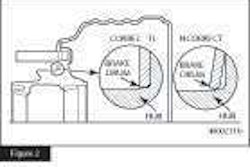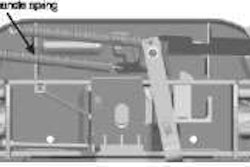Gladhand Inspection
The gladhands are a critical piece of the air system and need to be maintained. Because gladhands connect downstream of the air system dryer, failing to care for them will allow moisture to penetrate the system and cause problems, according to Phillips.
Gladhands have rubber seals that enable them to seal tightly. It is important to check gladhands regularly for leaks because the seals eventually wear out.
Drivers usually will hear leaks when they disengage the parking brakes or apply pressure to the service brakes. If the leak is generated at the gladhand seal it should be fixed immediately before air consumption is increased.
Increased air consumption weakens the desiccant in the dryer, ultimately resulting in a need for service, according to Phillips.
Another good preventive maintenance tip to share with drivers is to always affix the gladhands to their stowaways when dropping the trailer. If they are not kept sealed, the air brake system components could get damaged by debris entering, or in extreme cold temperatures by allowing moisture to freeze the service and parking brakes.
Other protecive options to consider:
• Anodized gladhands for added protecion against corrosive elements
• Filter screens to keep debris out of the air lines
• Polyurethane seals
• Stainless steel detent plates
• Powder- and zinc-coated detent plates
• Replacing gladhands everytime you replace air coils
Phillips Industries offers the following procedure on the proper way to replace worn gladhand seals.
• When using colored seals, put the proper color in each type of gladhand connector. Parking brake lines and fittings are red, while the service brakes are blue.
• There are two types of seals, those with a convex outside surface and those with a flat outside surface. The seal type varies with the type of gladhand although there are some universal gladhands.
• Remove the seal by gently prying it out with a screwdriver being careful not to damage the gladhand surface.
• Before installing the new seal, use a clean rag to wipe the gladhand cavity clean. Gently remove any debris.
• Install the new seal by positioning half of it in the air hole of the gladhand, aligning it squarely with the hole. Then press inward all around the seal surface to force it to lock into the groove all the way around. Rotate the seal several times once it’s in place to make sure it is seated properly.














